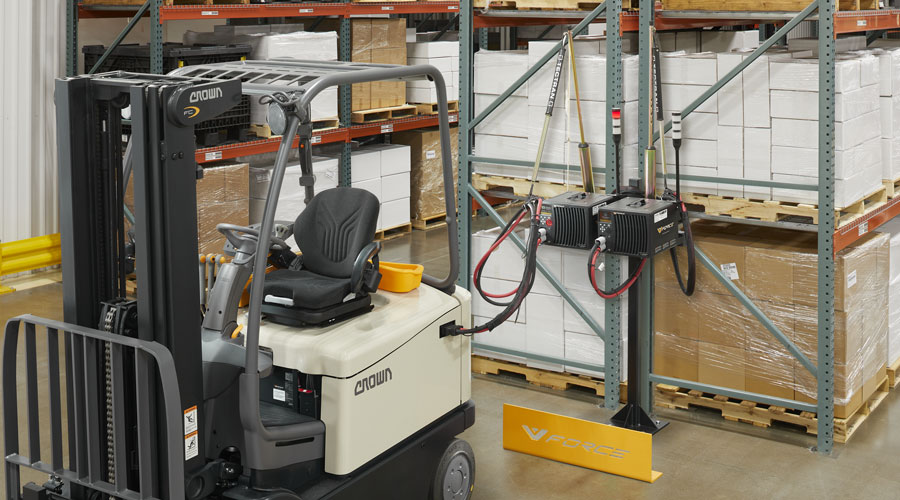A Different Kind of Cable Bill - The Cost of Improper Cable Management

Whether you’re charging lead-acid or lithium-ion forklift batteries, your charging processes can have a bigger effect on your operational productivity than you might imagine. A robust battery management program can enable you to better manage the usage, charging, changing and inventory of your batteries to optimize their performance levels.
Surprisingly, one factor often overlooked in such a program is the proper handling, maintenance and storage of charging cables and connectors. Paying inadequate attention to your charging cables can be costly and could negatively impact your productivity, equipment and maintenance cost.
Cable connections can be a primary failure point in forklift battery charging systems. Improper cable management can cause undue stress on cables and connections, leading to premature wear, tear and failure of connectors, including failures due to excessive heat during the charging process.
Forklift battery charging cables and connectors can become an even more common failure point when using lithium-ion batteries. Because these batteries are intended to be opportunity charged more often throughout a shift, charging cables can be put through many more connection-disconnection cycles, which leads to more cable and connector wear and tear than situations where traditional charging is used.
Replacement cost for damaged cables and connectors is just one cost of improper cable management, perhaps only a small portion of the total cost. When cables and connectors fail, it may result in inadequate charging due to poor connections or overheating. The charger may even fail to charge the battery at all, reducing forklift runtime. In some instances, these failures can result in a battery being unavailable for an entire shift.
There are also safety concerns associated with damaged or unsecured cables. For example, exposed cable wires could be hazardous during handling, while carelessly misplaced cables can become a tripping hazard or an obstacle for passing equipment.
Here are four tips to mitigate cable management errors in your forklift battery charging strategy.
1. Provide sufficient space to charge
When choosing locations for charging stations, remember to consider their placement from a cable management perspective. Ensure that there is sufficient space to properly position your forklift for charging, especially if you intend to co-locate two or more forklift battery charging stations. If there is not enough room, certain charging stations might be used more often than others, accelerating the wear and tear of their charging cables. Also avoid situations that result in cables being stretched or improperly routed while charging.
2. Ensure that you have the right charging accessories
There are a number of cable management accessories available that are designed to secure charging cables, keeping them off the floor and helping prevent cable damage and clutter. These include:
- Charger stands that feature heavy-duty steel frames and securely anchor to the floor, with mounting brackets to hold chargers in place.
- Pogo sticks that keep battery connectors and cables off the floor when not in use at charging stations, preventing damage and wear.
- Tender kits with heavy-duty clamps to secure large battery cables with or without pogo sticks.
- Adjustable cable retractors that have adjustable spring tension to hold large cables. Ideally, retractors should be mounted to a charger stand, shelf or wall bracket.
- Robust connectors, handles and strain relief protectors can also assist operators with making aligned and secure connections without damage to connector housings while protecting contacts and cables from corrosion and potential short circuits.
3. Ask your provider about a planned maintenance program
A forklift battery maintenance program is designed to reduce unexpected downtime and related service costs while maintaining battery life and performance.
Connectors can break internally, so you may not even notice that the cable connector is damaged without a closer inspection. When connectors are damaged, the charger will still attempt to deliver a full charge, but the hidden damage will accelerate their failure. A loose connection generates heat, which could result in the melting of the connector. Additionally, connectors typically have a limited life span, so a robust PM program should plan for their replacement.
As your forklift battery maintenance program progresses, your technician will also be able to alert you to potential damage resulting from process issues. They are trained to recognize the effects of sustained improper behaviors that risk damage to cables, connectors and batteries.
4. Provide operators with the necessary training
Last but not least, ensure that cable management is a part of your forklift operator training program. Even if you follow the previous three tips, your efforts could be negated if you don’t have the necessary training in place to educate your operators and reinforce proper behavior.
Your operators should understand the importance of cable management and how to use cable management accessories properly. They should also be trained in properly positioning the lift truck at the charging station so as not to bend or strain the cables.
Best practices, such as checking connections frequently to make sure they are secured, noting damaged cables or connectors, and never disconnecting the battery from the charger without first turning off the charger, should also be reinforced.
Whether your application uses lead-acid or lithium-ion batteries, or a mixture of both, implementing a battery management system that includes proper cable management can help increase the performance and life of your forklift batteries. Healthy batteries are a key component of healthier forklifts that can help you achieve your productivity and uptime goals.
To learn more, visit the V-Force® Energy Solutions page on crown.com.